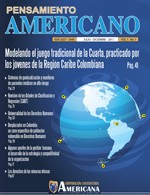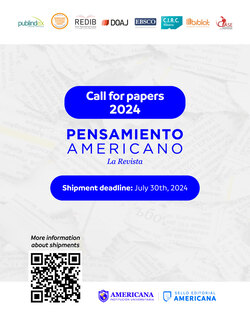Displaced persons in Colombia: a specific case of a vulnerable population in human rights
Keywords:
Displacement, Conflict, ViolenceAbstract
Displacement is a phenomenon of involuntary migration caused by violence, in which individuals and families not
directly involved in the fight, they are forced to move from their place of origin to protect their life or physical integrity.
As a violation of humanitarian law is a situation which embodies the simultaneous violation of civil, political, economic,
social and cultural rights. Colombia is one of the world’s countries with the largest number of IDPs. Until May
2011 the Government of Colombia has registered more than 3.7 million IDPs in the country. The Consultancy for
Human Rights and Displacement (CODHES) consider that the actual number of people displaced by internal armed
conflict since the mid-80’s than 5 million people. IDPs lose everything, leave their homes, property and livelihoods
and are in constant danger either reprisals or that a new outbreak of violence becomes necessary to move again, for
these circumstances and the alarming number of displaced since mid-1997 the Government of Colombia requested
ACNUR to provide advice to the national institutions responsible for caring for the displaced population and for this it
was necessary to establish an office in the country. With the consent of the Secretary General of the United Nations,
ACNUR responded favorably to the request of the Government of Colombia and in June 1998 opened an office in Bogotá
in order to contribute to strengthening national capacity to address the problem of displacement, meeting today
in 13 cities across the country due to extreme poverty and vulnerability in this population is located in Colombia.
Downloads
References
ALTAMIRANO, Teófilo (1992), Éxodo. “Peruanos en el exterior”, Lima, Fondo editorial de la P. U. Católica del Perú.
ARBOLEDA, Sergio, (2005), “La situación de derechos humanos en las zonas de frontera colombianas”, Asesor de la Coordinación de Atención al desplazamiento Forzado de la Defensoría del Pueblo de Colombia. En: ACNUR – La Agencia de la ONU para los refugiados, EUROPEAID
Oficina de Cooperación, Defensoría del Pueblo Colombia, Memorias del Seminario-Taller Internacional de contextualización
sobre desplazamiento forzado y refugio en zonas de frontera, Bogotá, D.C., enero.
ARBOLEDA, Urbenel, (2005), “Políticas para la atención al desplazamiento forzado en Colombia”, Director Operación territorial de la red Solidaridad Social, Colombia.
ACNUR – La Agencia de la ONU para los refugiados, EUROPEAID Oficina de Cooperación, Defensoría del Pueblo Colombia, “Memorias del Seminario-Taller Internacional de contextualización sobre desplazamiento forzado y refugio en zonas de frontera”, Bogotá, D.C.
Departamento de Asuntos Económicos y Sociales de la Secretaría de las Naciones Unidas, “Boletín sobre Políticas de Integración Social”, Volumen 1, No 4 -2002.
Departamento de Asuntos Económicos y Sociales de la Secretaría de las Naciones Unidas, “Poblaciones vulnerables a luz de la Conferencia de Durban: casos de América Latina y el Caribe”, Boletín sobre Políticas de Integración Social, Volumen 2, No – 2003.
Informe Anual de Derechos Humanos y DIH (2004), Capítulo II, Colombia, pp. 55-67. En: http://www.derechoshumanos. gov.co/descargas/informe2004/informeanual2004.pdf
ONU – Organización de la Naciones Unidas, “Conferencia Mundial contra el Racismo, la Discriminación Racial, la Xenofobia y las Formas Conexas de Intolerancia”, Declaración y Programa de Acción, Nueva York, 2002.
SOBERÓN, Ricardo, (2005), “Movimientos transfronterizos desde Colombia”, Ex Coordinador Programa Fronteras de Project Counseling Service, Perú. En: ACNUR – La Agencia de la ONU para los refugiados, EUROPEAID
Oficina de Cooperación, Defensoría del Pueblo Colombia, Memorias del Seminario-Taller Internacional de contextualización
sobre desplazamiento forzado y refugio en zonas de frontera, Bogotá, D.C.
SUÁREZ, Harvey, (2005), “Dinámica del desplazamiento forzado en Colombia, Consultoría para los derechos Humanos y el desplazamiento, CODHES. En: ACNUR – La Agencia de la ONU para los refugiados,
EUROPEAID Oficina de Cooperación, Defensoría del Pueblo Colombia, Memorias del Seminario-Taller Internacional de contextualización sobre desplazamiento forzado y refugio en zonas de frontera, Bogotá, D.C., enero
Downloads
Published
Issue
Section
License
Copyright (c) 2011 Pensamiento Americano

This work is licensed under a Creative Commons Attribution-NonCommercial-NoDerivatives 4.0 International License.
The author or authors of an article accepted for publication in the Journal Pensamiento Americano will transfer all of the patrimonial rights to the American University Corporation free of charge, within which are included: the right to edit, publish, reproduce and distribute both print media as digital, in addition to include in article in international indexes and / or databases, likewise, the Editorial Seal is authorized to use the images, tables and / or any graphic material presented in the article for the design of covers or posters from the same magazine. By assuming the patrimonial rights of the article, it may not be partially or totally reproduced in any printed or digital media without its express permission.
AUTHORITY ASPECTS
For the Pensamiento Americano Journal, all the authors of an article have made substantial contributions to the research and the manuscript, and they share the responsibility when the article presents errors, fraud in some way or violations of copyright.
After submitting an article, the journal does not accept the addition, deletion or change in the order of the authors, in addition we reserve the right to release the article when it has been submitted to the journal and under no circumstances will American Thought accept the article. withdrawal of an article during any phase of the editorial process






